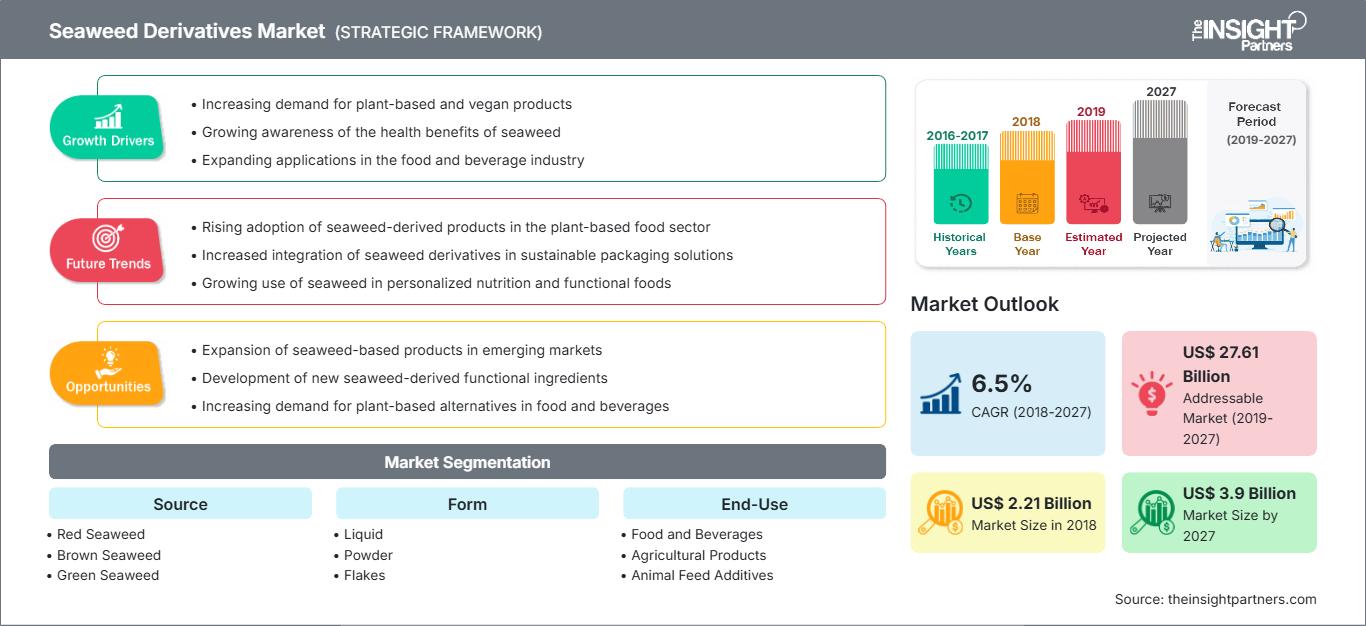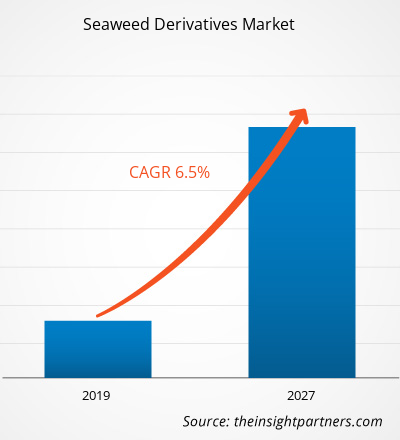The seaweed derivatives market was valued at US$ 2,210.35 Mn in 2018 and is projected to reach US$ 3,903.91 Mn by 2027; it is expected to grow at a CAGR of 6.5% from 2019 to 2027.
Seaweeds are basically red, brown and green marine microalgae, whose extracts are used in the horticultural crops for its plant growth promoting effects. The chemical derivatives of seaweed include fatty acids and vitamins, mineral nutrients, phytoharmones, and complex polysaccharides, among others. Major derivatives of seaweed include alginates, carrageenans, and agars. Alginates are largely extracted from brown seaweeds, while carrageenans and agars are largely extracted from red seaweeds. Alginates, carrageenans, and agars are increasingly used in food and beverage, animal feed, and agriculture industry among others.
In 2018, Asia Pacific held largest share in the global seaweed derivatives market, followed by Europe and North America. Increasing demands from food and beverage, animal feed, and agriculture industry is mainly driving the market in Asia Pacific region. China, South Korea, and Japan are the major producers and consumers of seaweed derivatives in the Asia Pacific region.The market is majorly driven by the wider application of seaweed derivatives in food and beverage industry. It is increasingly being used in fertilizers which improves crop yield and increases the crop’s strength, which helps in pest resistance. Rising consumer awareness regarding health benefits of seaweed derivatives is majorly boosting the seaweed market. Also, rising demand of organic food products fuel the growth of seaweed derivatives market. Less awareness among the farmers regarding the extraction of seaweed is resisting the market growth of seaweed derivatives.
COVID-19outbreak first began in Wuhan (China) inDecember 2019, and since then it has spread across the globeat a fast pace.China, Italy, Iran, Spain, the Republic of Korea, France, Germany, and the US are among the worst affected countries in terms of positive cases and reported deaths as of March 2020. The COVID-19outbreak has affected economies and industries in various countries due to lockdowns, travel bans, and business shutdowns. The global food and beverage industry is one of the major industries suffering serious disruptions such as supply chain breaks, technology events cancellations, and office shutdowns as a result of this outbreak.For instance, China is the global hub of manufacturing and the largest raw material supplier for various industries. The overall market break down due to COVID-19 is also affecting the market growth of seaweed derivatives due to shutting down of factories, obstacle in supply chain, and downturn in world economy.
Customize This Report To Suit Your Requirement
You will get customization on any report - free of charge - including parts of this report, or country-level analysis, Excel Data pack, as well as avail great offers and discounts for start-ups & universities
Seaweed Derivatives Market: Strategic Insights

-
Get Top Key Market Trends of this report.This FREE sample will include data analysis, ranging from market trends to estimates and forecasts.
Market Insights
Rising demand form food and beverage industry has favored the seaweed derivatives market globally
Seaweed derivatives such as agars, alginates, and carrageenans are extensively used in various food and beverage products. These derivatives are used in a wide range of food and beverages such as ice cream, syrup, lunch meats, baby formula, almond milk, whipped cream, candy bars, chocolate milk, coffee beverages (e.g., iced coffee and soy-based coffee drinks), coffee creamer, ricotta cheese, yogurt, cottage cheese, and sour cream, among others. Carrageenans are used as a thickening ingredient in puddings, chocolate milk, chewing gum, jams, and jellies. Additionally, carrageenans reduce waste by extending the shelf life of foods without any loss of quality. Various foods, such as mayonnaise and salad dressing, would separate without the help of a stabilizer. Therefore, carrageenan is used as a stabilizing agent in mayonnaise and salad dressing. Therefore, a wide range of applications of seaweed derivatives in the food and beverage industry boosts the growth of the seaweed derivatives market globally.
Source Insights
Based on source, the seaweed derivatives market is segmented into red seaweed, brown seaweed and green seaweed. In 2018, the red seaweed segment accounted for the largest share of the global seaweed derivatives market. Red seaweed tends to possess the highest protein levels, which are responsible for its red color. Despite being found in the shallow waters, red seaweeds are capable of withstanding deep water and low light conditions. These factors boost the growth of red seaweed derivatives market.
FormInsights
Based on form, the seaweed derivatives market is segmentedinto liquid, powder, and flakes.In 2018, the liquid segment accounted for the largest share ofthe global seaweed derivatives market; however, the powdersegment is expected to register the fastest growth rate during the forecast period. Liquid derivatives from brown seaweed are marketed for use in horticulture and agriculture. The liquid seaweed derivatives are used at high dilution rates, which results in minimal quantities of material being applied in the given area. The actives substances in liquid seaweed derivatives are capable of affecting such low temperatures.
End-UseInsights
Based on end-use, the seaweed derivatives market is segmentedinto food and beverages, agricultural products, animal feed additives, pharmaceuticals, and others.In 2018, the food and beveragessegment accounted for the largest share of the global seaweed derivatives market; however, the animal feed additivessegment is expected to register the fastest growth rate during the forecast period. Seaweed derivatives such as alginates are widely used in bakery products, candies, dairy products, salad dressings, ice creams, and creams and jellies, as well as in sausages, processing meats, and fish. It is also used in clarifying beers and wines. Alginates are completely organic and are a substance safe for food application. Additionally, alginates are capable of thickening a solution when they get dissolved in water. Moreover, alginates can form gels when they are added to a calcium salt solution. Therefore, alginates are primarily used in salad dressings and mayonnaise.
Seaweed Derivatives Market Regional InsightsThe regional trends and factors influencing the Seaweed Derivatives Market throughout the forecast period have been thoroughly explained by the analysts at The Insight Partners. This section also discusses Seaweed Derivatives Market segments and geography across North America, Europe, Asia Pacific, Middle East and Africa, and South and Central America.
Seaweed Derivatives Market Report Scope
| Report Attribute | Details |
|---|---|
| Market size in 2018 | US$ 2.21 Billion |
| Market Size by 2027 | US$ 3.9 Billion |
| Global CAGR (2018 - 2027) | 6.5% |
| Historical Data | 2016-2017 |
| Forecast period | 2019-2027 |
| Segments Covered |
By Source
|
| Regions and Countries Covered |
North America
|
| Market leaders and key company profiles |
|
Seaweed Derivatives Market Players Density: Understanding Its Impact on Business Dynamics
The Seaweed Derivatives Market is growing rapidly, driven by increasing end-user demand due to factors such as evolving consumer preferences, technological advancements, and greater awareness of the product's benefits. As demand rises, businesses are expanding their offerings, innovating to meet consumer needs, and capitalizing on emerging trends, which further fuels market growth.

- Get the Seaweed Derivatives Market top key players overview
Global Seaweed DerivativesMarket – By Source
- Red Seaweed
- Brown Seaweed
- Green Seaweed
Global Seaweed DerivativesMarket – By Form
- Liquid
- Powder
- Flakes
Global SEAWEED DERIVATIVES Market – By End-Use
- Food and Beverages
- Agricultural Products
- Animal Feed Additives
- Pharmaceuticals
- Other End Use
Company Profiles
- W Hydrocolloids, Inc.
- KIMICA Corporation
- DuPont de Nemours, Inc.
- Gelymar S.A.
- CP Kelco
- ALGAIA
- Compañía Española de Algas Marinas, S.A.
- Cargill, Incorporated
- ARTHUR BRANWELL & CO
- AGARMEX, S.A. DE C.V.
Frequently Asked Questions
Which region held the largest share of the global seaweed derivatives market?
Based on source, which segment is leading the global seaweed derivatives market during the forecast period?
Can you list some of the major players operating in the global seaweed derivatives market?
- Historical Analysis (2 Years), Base Year, Forecast (7 Years) with CAGR
- PEST and SWOT Analysis
- Market Size Value / Volume - Global, Regional, Country
- Industry and Competitive Landscape
- Excel Dataset
Recent Reports
Testimonials
Reason to Buy
- Informed Decision-Making
- Understanding Market Dynamics
- Competitive Analysis
- Identifying Emerging Markets
- Customer Insights
- Market Forecasts
- Risk Mitigation
- Boosting Operational Efficiency
- Strategic Planning
- Investment Justification
- Tracking Industry Innovations
- Aligning with Regulatory Trends





















 Get Free Sample For
Get Free Sample For